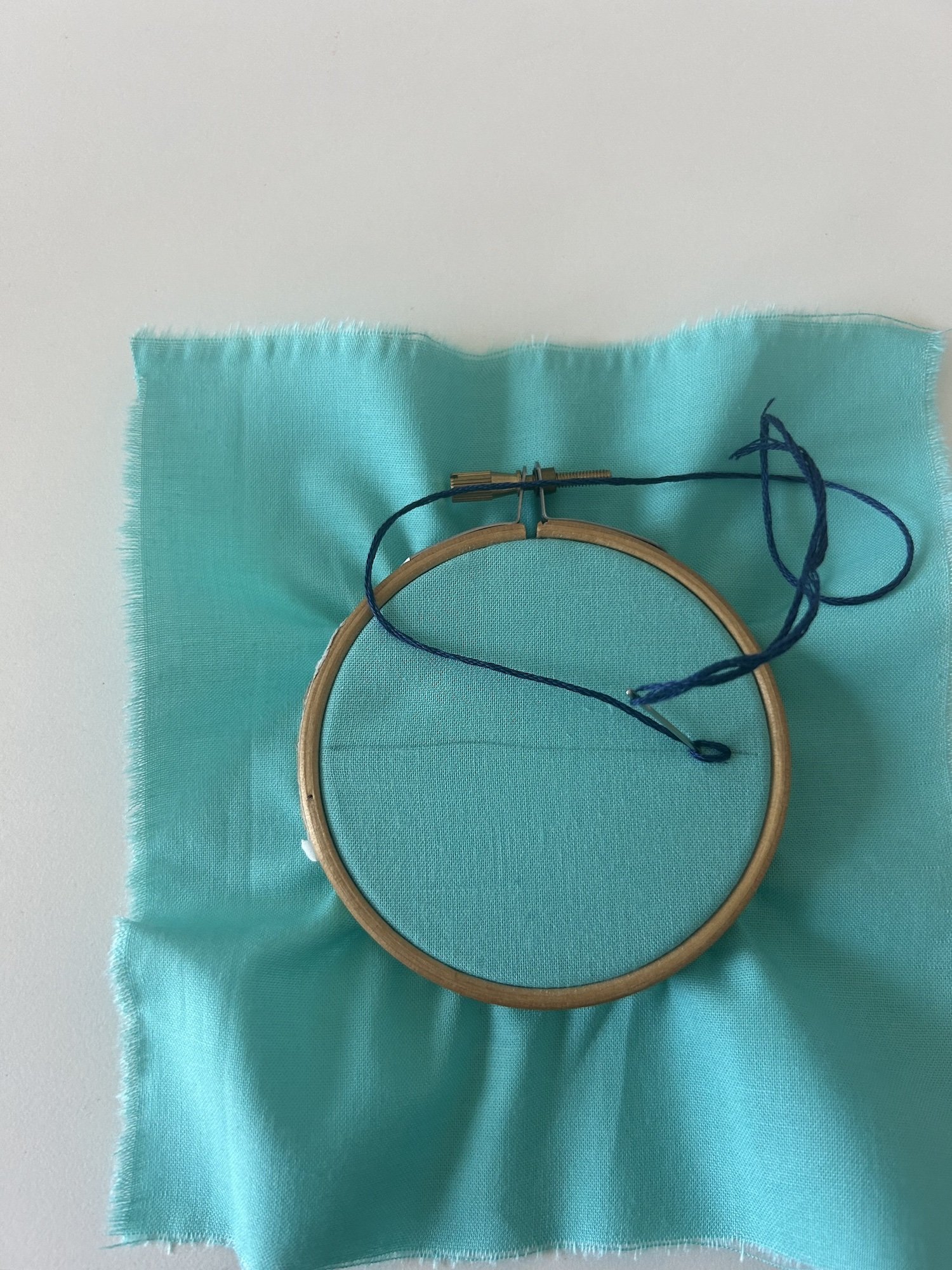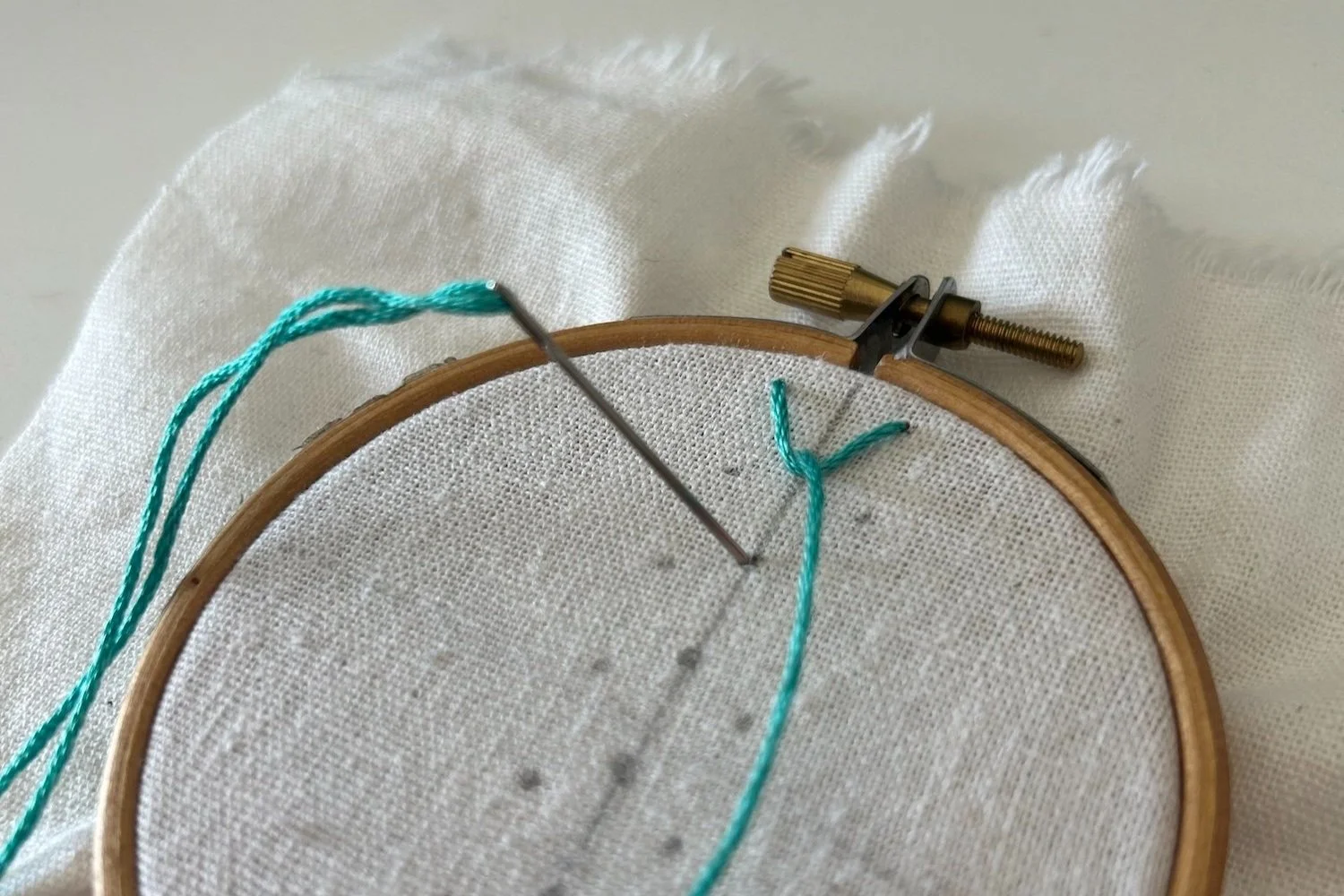Chain Stitch
Chain Stitch
A chain made of link like stitches that can be used as an outline to shapes and for lines.
Embroidery, an ancient art form that has evolved across cultures and centuries, boasts a variety of techniques, each with its own unique charm. Among these, the chain stitch stands out for its versatility, ease of execution, and potential to create both intricate and bold designs. Whether you’re a beginner or a seasoned embroiderer, the chain stitch is a fundamental technique that offers endless possibilities for creativity.
In this blog post, we’ll explore the history, variations, and uses of the chain stitch, as well as a detailed step-by-step guide on how to master it. By the end, you’ll have a deep understanding of how to incorporate this stitch into your embroidery projects, from outlining shapes to creating textures and filling spaces.
What is a Chain Stitch?
A chain stitch is a series of looped stitches that resemble the links of a chain. Each loop is connected to the next, creating a continuous line of stitches that can be curved, straight, or even circular. The stitch is incredibly versatile and can be used for outlining, filling large areas, or creating intricate patterns and textures. Because of its looping nature, the chain stitch has a raised texture, which adds dimension to embroidery projects.
One of the reasons the chain stitch is so popular is its adaptability. You can use it to create bold, eye-catching outlines or fill in areas with dense, decorative stitching. Additionally, chain stitch variations—such as the detached chain stitch or heavy chain stitch—offer even more opportunities for experimentation and creativity.
How To Create A Chain Stitch
Materials You Will Need
Fabric. Any type of fabric can be used for chain stitch, but tightly woven fabrics made of natural fibers like cotton or linen work best for achieving clean, even stitches.
Embroidery Floss. Choose your desired color of embroidery floss. The thickness of the thread will determine how bold or delicate your chain stitch appears.
Embroidery needle. Use a needle with a sharp point and an eye large enough to accommodate your floss.
Embroidery hoop. This will help keep your fabric taut to make stitching easier and help your fabric from puckering.
Scissors. To trim your thread.
Steps for Creating a Chain Stitch
Step 1. Prepare your fabric. Secure your fabric in an embroidery hoop to keep it taut and smooth. This will help ensure even stitches and prevent puckering.
Step 2. Thread your needle with your embroidery floss that is the length of your arm or 18-24” long. Leave a 2” tail on one side of your needle. Knot the end of the longer side of the floss.
Step 3. Bring the needle through the fabric. Starting from the back of the fabric, pull the needle up through the fabric where you want to begin your chain stitch.
Step 4. Form the first loop. Insert the needle back into the fabric near the same point where the thread emerged, leaving a small loop of thread on the surface of the fabric. Pull the thread gently, leaving the loop loose enough to form the first link in your chain.
Step 5. Anchor the loop. Bring the needle back up through the fabric a short distance away from the first insertion point, making sure that the needle emerges inside the loop of thread. As you pull the needle through, the loop will form your first chain link.
Step 6. Repeat the process. To continue the chain stitch, insert the needle again near the point where the thread emerged from the previous loop, leaving a new loop on the surface. Bring the needle back up inside this loop, repeating the process to create a chain of loops.
Step 7. Finish the stitch. To end the chain stitch, bring the needle up through the fabric as you would normally, but instead of forming another loop, insert the needle just outside the last loop and pull the thread through tightly to secure the chain.








History of Chain Stitch
The chain stitch is one of the oldest embroidery stitches, with origins dating back thousands of years. It has been found in ancient textiles from a variety of cultures, including China, Egypt, Persia, and India. The stitch’s versatility made it a favored choice for both decorative and practical purposes, from embellishing clothing and household items to creating detailed tapestries and ceremonial garments.
In ancient China, chain stitch was often used in silk embroidery, where artisans would create detailed scenes and motifs on luxurious fabrics. Similarly, Indian embroidery traditions like zardozi and ari rely heavily on the chain stitch for their intricate designs. In Persia, chain stitch was employed in decorative textiles, often combined with metallic threads and embellishments to create richly textured patterns.
Chain stitch also played a significant role in European embroidery, particularly during the Middle Ages and Renaissance. It was used to adorn ecclesiastical garments, tapestries, and royal attire, often in combination with other stitches to create elaborate designs. Today, chain stitch continues to be a fundamental stitch in both traditional and modern embroidery, appreciated for its beauty, simplicity, and versatility.
Ways to Use Chain Stitch Embroidery
The chain stitch is a versatile and dynamic stitch that can be used in a variety of ways to enhance your embroidery projects. Here are some common uses:
Outlining Designs
One of the most popular uses for chain stitch is as an outline stitch. Its looping structure creates a thicker, more prominent line than other outline stitches like the backstitch or stem stitch. This makes it perfect for outlining shapes or letters in your embroidery.
Filling Large Areas
Chain stitch can also be used to fill large areas of a design, either by working the stitch in rows or creating a more organic, freeform pattern. This is particularly effective when you want to add texture or dimension to a background or central motif.
Floral Patterns
In floral embroidery, chain stitch is frequently used to create stems, leaves, and petals. The detached chain stitch (or lazy daisy stitch) is especially popular for creating flower petals, while the basic chain stitch is often used for stitching curved stems or vines.
Borders and Edges
Chain stitch is an excellent choice for creating decorative borders or edges in embroidery. The loops of the chain stitch create a textured, braided effect that can add interest and definition to the edge of a design or garment.
Textured Details
Because of its raised, looping structure, chain stitch is ideal for adding texture to specific areas of a design. For example, you might use chain stitch to create textured hair, animal fur, or waves in a landscape scene.
Lettering
Chain stitch works well for embroidered lettering, particularly when you want bold, decorative text. The loops of the stitch create a thicker, more prominent line than other stitches, making the text stand out in your design.
Level Up Your Chain Stitch
While the basic chain stitch is incredibly useful on its own, there are several variations that can expand your creative potential. Here are some of the most popular chain stitch variations:
Detached Chain Stitch (Lazy Daisy Stitch)
The detached chain stitch, also known as the lazy daisy stitch, is similar to the basic chain stitch but is worked as individual, isolated loops. This stitch is commonly used to create petal shapes in floral designs. To create a detached chain stitch, follow the same steps as the basic chain stitch but secure each loop with a small straight stitch at the end.
Heavy Chain Stitch
The heavy chain stitch is a thicker, more substantial version of the basic chain stitch. It’s worked by making each loop longer and overlapping them slightly as you stitch. This variation is great for creating bold outlines or filling larger areas with a more pronounced texture.
Split Chain Stitch
In the split chain stitch, each loop is split by bringing the needle up through the center of the loop instead of inside the loop. This creates a more textured, twisted appearance that can add extra depth to your designs. The split chain stitch is often used for outlining or adding dimension to certain areas of an embroidery project.
Double Chain Stitch
The double chain stitch is a decorative variation that involves stitching two rows of chain stitch side by side. This creates a braided or intertwined appearance, making it ideal for borders, decorative trims, or bold outlines.
Romanian Chain Stitch
In the Romanian chain stitch, each loop is secured with a small horizontal stitch. This technique results in a more defined and sturdy chain, often used for creating outlines or decorative edges.









